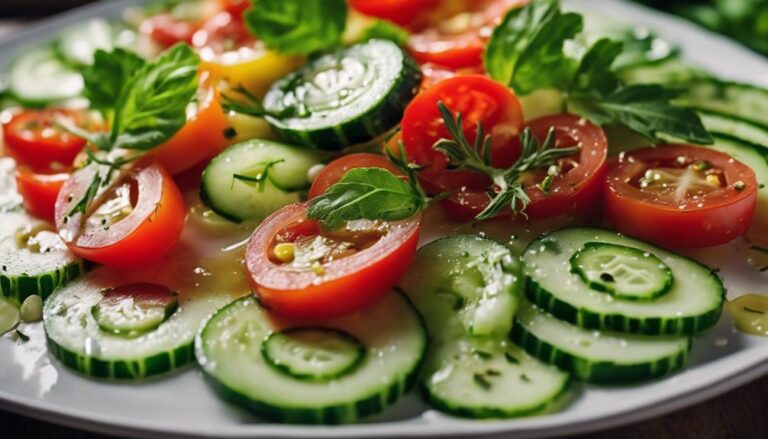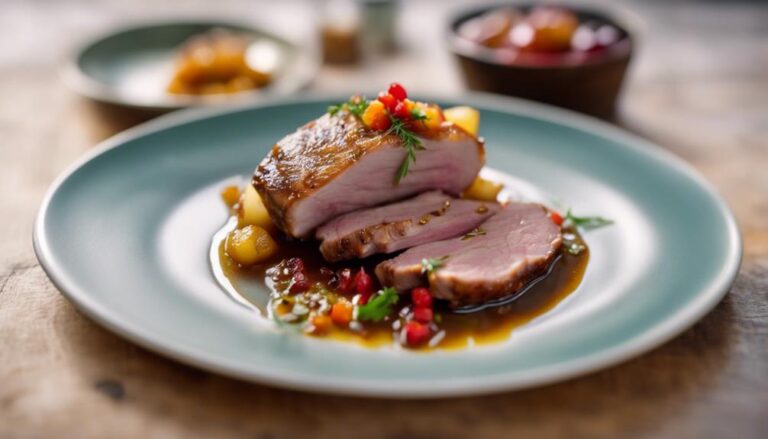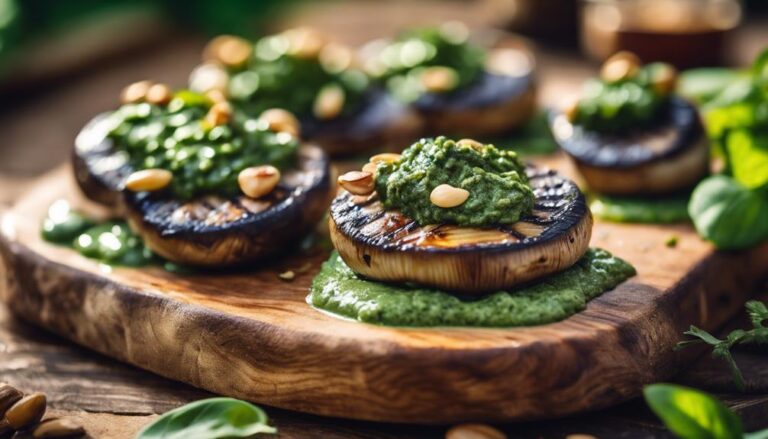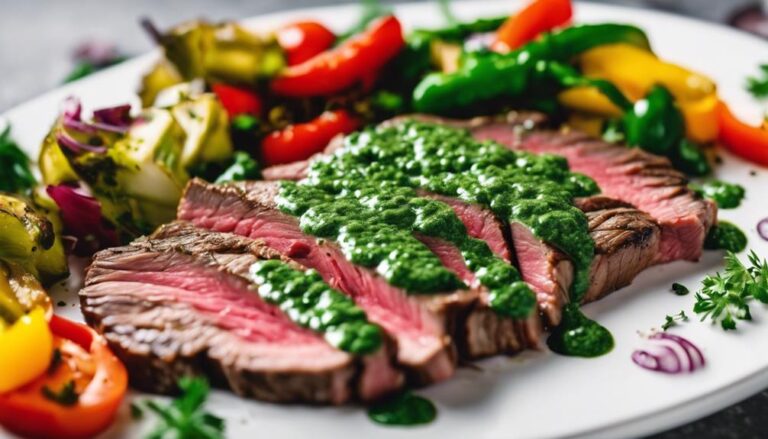Sous Vide Tuna Steak With Olive Tapenade
Experience a flavor explosion with sous vide tuna steak paired with zesty olive tapenade. Harness the full potential of moisture and flavor by cooking the tuna gently in a water bath. Let the Mediterranean charm elevate your taste buds as the succulent tuna combines with the briny essence of the tapenade. Precision is key to achieving the perfect texture and taste. Discover the magic of fusion techniques and traditional flavors coming together in this delightful dish. Express your culinary creativity and savor this delectable creation that celebrates the best of both worlds. Learn more about enhancing tuna dishes with culinary innovations and key flavor enhancers.
What You Will Learn Here
- Sous vide cooking preserves tuna's moisture and flavor.
- Olive tapenade adds briny and tangy Mediterranean notes.
- Precision in cooking ensures perfect texture in tuna steak.
- Vacuum-sealing before cooking enhances tuna's succulence.
- Experiment with complementary flavors for a delectable dish.
Tuna's Mediterranean Culinary Journey
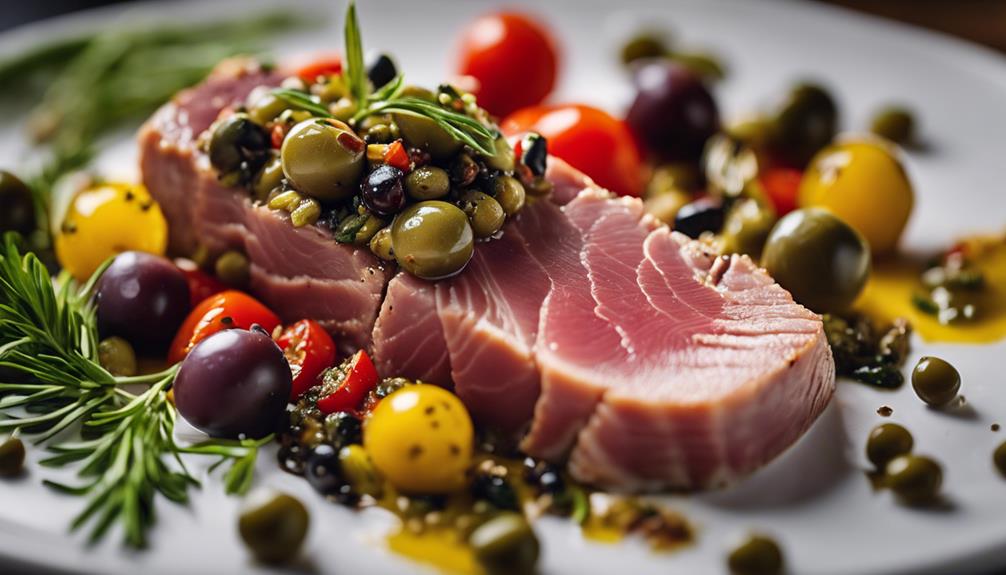
Tuna's Mediterranean culinary journey showcases its flavor evolution, from being a staple in traditional dishes to a star in contemporary cuisine.
The origins of olive tapenade, a classic accompaniment to tuna, can be traced back to the Mediterranean region.
Culinary fusion techniques blend the rich history of tuna and olive tapenade with modern cooking methods to create innovative and delicious dishes.
Tuna's Flavor Evolution
How did tuna's flavors evolve throughout its culinary journey in the Mediterranean region? Tuna's flavor evolution in the Mediterranean can be attributed to a variety of culinary techniques developed over centuries. The Mediterranean region has a long history of tuna fishing and consumption, leading to the creation of diverse and flavorful dishes.
In ancient times, tuna was often preserved through salting or curing methods to prolong its shelf life. These preservation techniques not only preserved the fish but also infused it with intense flavors. As Mediterranean culinary practices evolved, tuna became a staple ingredient in dishes like pasta, salads, and grilled preparations.
The use of herbs, citrus fruits, and olive oil in Mediterranean cuisine further enhanced the flavor profile of tuna. These ingredients complemented the natural richness of the fish, creating a harmonious blend of tastes. Whether grilled, seared, or served raw, tuna's versatility in Mediterranean cooking has allowed for a wide range of flavor combinations to develop, making it a beloved ingredient in this culinary tradition.
Olive Tapenade Origins
Exploring the origins of olive tapenade in the Mediterranean region adds a flavorful dimension to understanding tuna's culinary journey. Olive tapenade, a savory paste made from olives, capers, anchovies, and olive oil, is a staple in Mediterranean cuisine. The rich and robust flavors of olive tapenade complement the delicate taste of tuna, creating a harmonious culinary experience.
Traditional tapenade recipes hail from Provence, France, where the mixture was originally pounded into a paste using a mortar and pestle. Over time, variations of tapenade have emerged, incorporating ingredients like garlic, lemon juice, and herbs to enhance the flavors. The briny and tangy notes of olives combined with the umami taste of anchovies create a complex profile that elevates the taste of tuna steaks.
When paired with sous vide tuna steak, the olive tapenade adds a burst of Mediterranean flavors, showcasing the fusion of land and sea in a single dish. Understanding the roots of olive tapenade provides insight into how this classic condiment has traveled through various culinary traditions to enhance dishes like sous vide tuna steak.
Culinary Fusion Techniques
Incorporating diverse culinary traditions enhances the Mediterranean journey of tuna, showcasing a fusion of flavors that tantalize the taste buds. Fusion techniques play a significant role in the evolution of tuna dishes, where culinary innovation meets traditional recipes. Imagine the harmony of Japanese sashimi techniques merging with Italian herb-infused olive oils, creating a symphony of taste on your plate. By blending cooking methods and ingredients from different regions, chefs craft new and exciting ways to enjoy tuna, elevating it from a simple protein to a culinary masterpiece.
Culinary fusion techniques allow for endless experimentation, resulting in delightful surprises for your palate. Picture a perfectly seared tuna steak topped with a vibrant Mediterranean olive tapenade, a marriage of flavors that transports you to sun-soaked shores with each bite. This blend of culinary influences not only celebrates diversity but also pushes the boundaries of traditional cooking, inviting you to savor the rich tapestry of flavors that the Mediterranean has to offer. So, be bold in your culinary explorations, and let fusion techniques guide you on a mouthwatering journey through the world of tuna cuisine.
Tuna's Key Flavor Enhancers
To enhance the flavor of your tuna steak, consider incorporating key ingredients such as fresh herbs, garlic, and citrus zest. These elements can elevate your tuna dish to new heights by adding layers of complexity and depth to the taste profile.
When preparing your tuna, here are some flavor enhancers you can experiment with:
- Umami bombs: Think of ingredients like soy sauce, miso paste, or Worcestershire sauce to enhance the savory notes in your tuna.
- Marinade secrets: Create a flavorful marinade using ingredients such as olive oil, lemon juice, and a touch of honey to tenderize the tuna and infuse it with delicious flavors.
- Herbaceous freshness: Chop up some parsley, cilantro, or dill to bring a burst of freshness to your tuna steak.
- Garlic magic: Whether roasted, minced, or sliced, garlic can add a robust and aromatic element to your tuna dish.
Tasty Tuna Creations
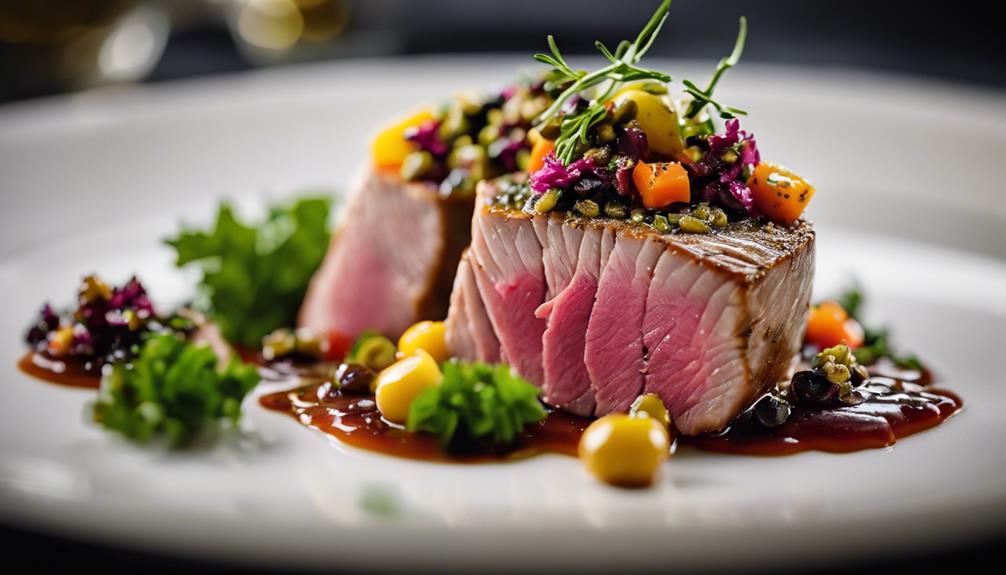
When it comes to creating tasty dishes with tuna, there are several delicious options to explore.
From a mouthwatering Tuna Tartare recipe to the simplicity of Olive Oil Seared Tuna Steaks and the freshness of a Tuna Nicoise Salad, the possibilities are endless.
Whether you prefer your tuna raw, seared, or tossed in a vibrant salad, these recipes showcase the versatility and flavor of this beloved fish.
Mouthwatering Tuna Tartare Recipe
Indulge in the exquisite flavors of a mouthwatering Tuna Tartare that will tantalize your taste buds with each bite. If you're a seafood lover looking for a rejuvenating and flavorful dish, this Tuna Tartare recipe is sure to impress.
Here are some key points to pique your interest:
- Sushi grade: Utilize the best quality sushi-grade tuna for a fresh and authentic taste.
- Hand-chopped: The tuna is finely hand-chopped to guarantee the perfect texture in every bite.
- Zesty Citrus: A burst of zesty citrus flavors from fresh lemon or lime juice enhances the tuna's natural taste.
- Herbaceous: Fresh herbs like cilantro or chives add a pop of color and herbaceous aroma to the dish.
With the combination of sushi-grade tuna, hand-chopped freshness, zesty citrus notes, and herbaceous hints, this Tuna Tartare recipe promises a delightful culinary experience. Whether as an appetizer or a light main course, this dish is bound to elevate your dining experience with its vibrant flavors and textures.
Olive Oil Seared Tuna Steaks
For a delectable twist on tuna, try searing tuna steaks in olive oil to create a flavorful and satisfying dish. Here are some tips to elevate your grilled tuna game:
- High-Quality Tuna: Start with fresh, high-quality tuna steaks for the best flavor and texture.
- Marinate with Olive Oil: Enhance the taste by marinating the tuna steaks in a blend of olive oil, herbs, and seasonings before grilling.
- Preheat Grill: Make sure your grill is preheated to high heat to get a nice sear on the tuna steaks.
- Flipping Technique: Grill the tuna steaks for a short time on each side to keep them moist and tender while still achieving a delicious charred exterior.
Tuna Nicoise Salad Recipe
To expand your culinary repertoire beyond olive oil-seared tuna steaks, consider indulging in the delightful flavors of a Tuna Nicoise Salad Recipe. This classic French dish brings together Mediterranean flavors in an invigorating and satisfying way. Here are some reasons why you should try this delectable salad:
- Bursting with Mediterranean ingredients like olives, tomatoes, and green beans.
- Incorporates protein-rich tuna, making it a hearty and nutritious meal.
- The combination of flavors, from briny olives to fresh veggies, creates a taste sensation.
- A versatile dish that can be enjoyed as a light lunch or a filling dinner option.
Indulge in the culinary artistry of a Tuna Nicoise Salad Recipe, where every bite embodies the essence of Mediterranean cuisine intertwined with the elegance of a classic French favorite.
Sealing in Tuna's Juices
To seal in the juices of your tuna steak, it's crucial to make sure that it stays moist, flavorful, and tender throughout the cooking process.
By retaining the natural moisture within the tuna, you enhance its taste and preserve its delicate texture.
This method not only results in a juicy and succulent tuna steak but also elevates the overall dining experience.
Retaining Tuna's Moisture
Retaining moisture in your tuna steak is essential for ensuring a flavorful and succulent final dish. When cooking tuna, moisture retention techniques are vital to prevent the fish from becoming dry and tough. Using sous vide cooking is an excellent method to seal in the natural juices of the tuna steak. By vacuum-sealing the tuna in a bag before cooking it in a water bath at a precise temperature, you can maintain the tuna's tenderness and juiciness.
Compared to traditional cooking methods like grilling or pan-searing, sous vide provides a more controlled environment that helps the tuna steak retain its moisture throughout the cooking process. This gentle cooking technique allows the tuna to cook evenly without losing its natural juices, resulting in a tender and succulent texture that's hard to achieve with other methods.
To enhance your tuna steak's tenderness, consider using sous vide cooking for a moist and delicious outcome that will elevate your dish to a restaurant-quality level.
Enhancing Tuna's Flavor
Consider utilizing a vacuum-sealing method to preserve the natural juices of your tuna steak and enhance its flavor profile. By sealing the tuna in a vacuum bag before cooking, you can lock in its natural juices, ensuring a moist and flavorful result. This technique is particularly effective when paired with complementary flavors through flavor pairing. When choosing seasonings or marinades, opt for ingredients like lemon, garlic, herbs, or soy sauce that will enhance the tuna's taste without overpowering it.
Experiment with different cooking techniques to further elevate the flavor of your tuna steak. Sous vide cooking, for example, allows for precise control over the temperature, resulting in a perfectly cooked tuna with a tender texture. Grilling or searing the tuna briefly after sous vide can also add a delightful charred flavor to the dish. These cooking methods can help you achieve a well-rounded flavor profile that highlights the natural taste of the tuna while adding depth and complexity.
Preserving Tuna's Texture
For optimal results in preserving the texture of your tuna steak and sealing in its juices, consider utilizing a vacuum-sealing method before cooking. This technique is essential for maintaining the tenderness of the tuna steak throughout the cooking process. When using the sous vide technique, sealing the tuna steak in a vacuum bag helps to prevent any loss of moisture during cooking, resulting in a juicy and flavorful final dish.
Compared to other cooking methods, such as grilling or pan-searing, the vacuum-sealing method offers a more controlled environment for the tuna steak, ensuring that it retains its natural juices and remains tender. The gentle cooking process of sous vide further enhances the texture preservation of the tuna steak, allowing it to cook evenly and achieve the desired doneness without sacrificing its tenderness.
Final Thoughts

As you reflect on the flavorful journey of preparing and savoring this Sous Vide Tuna Steak With Olive Tapenade, remember the importance of precision in cooking techniques. Reflections on this culinary experience may highlight the delicate balance required in sous vide cooking – where exact temperature control guarantees the tuna steak's perfect texture while infusing it with the aromatic flavors of the olive tapenade.
Mastering cooking techniques like sous vide not only elevates your dishes but also deepens your understanding of how different cooking methods can enhance flavors and textures. The tenderness of the tuna steak achieved through sous vide exemplifies the marriage of science and culinary artistry, showcasing how attention to detail can result in a restaurant-quality dish right in your own kitchen.
Frequently Asked Questions
Can I Substitute Tuna With Another Type of Fish?
You can substitute tuna with another fish for a unique twist. Consider flavor profiles to complement your dish. Remember that different fish have varying textures and may require adjustments in cooking methods to achieve desired results.
How Can I Prevent the Tuna Steak From Becoming Dry?
To prevent your tuna steak from becoming dry, focus on cooking techniques for moisture retention. Consider marinating the tuna in a flavorful mixture to enhance taste. By incorporating these steps, you can guarantee a juicy and delicious outcome.
What Are Some Alternative Serving Suggestions for the Tapenade?
For vegetarian options, consider using the tapenade as a spread on crusty bread or as a topping for grilled vegetables. Pair it with a light white wine like Sauvignon Blanc or a crisp rosé.
Is It Necessary to Use a Vacuum Sealer for Sous Vide Cooking?
You don't have to use a vacuum sealer for sous vide cooking; alternative methods like zip-top bags work well. A good seal is essential for flavor retention. Just be sure to remove air and seal tightly.
Can I Prepare the Tapenade in Advance and Store It?
You can definitely prepare tapenade in advance and store it. Properly stored tapenade can preserve its flavors well, making it a convenient make-ahead option for meal prep. Just make sure you follow storage guidelines for best taste.
Conclusion
To sum up, sous vide tuna steak with olive tapenade is a delicious and flavorful dish that celebrates the Mediterranean culinary tradition.
By using key flavor enhancers and sealing in the tuna's natural juices, you can create a tasty and tender meal that's sure to impress your taste buds.
Whether you're a seafood lover or looking to try something new, this recipe is a must-try for anyone seeking a culinary adventure. Enjoy!






